Twenty years ago this week I drove across town to the nearest Target one afternoon as soon as my classes were out. My goal: The Super NES game case, where a brand new release was on sale. I’d seen it advertised in late-night MTV commercials, of all things, and the gushing EGM review from a couple of weeks before had me absolutely champing at the bit to play. Final Fantasy III was going to be amazing, I could just tell.
And I was right. I didn’t know about the series’ torrid history, the fact that this was properly Final Fantasy VI and that we’d missed the episode between this and Final Fantasy “II.” What I did know is that for the first time, a “proper” RPG felt as lively and engrossing and breezily fun as an action RPG, like Zelda, or SoulBlazer, or this game’s spiritual predecessor Secret of Mana, which I had freebased the previous winter. It looked great. The story was phenomenal by the standards of the medium. The music was amazing. And there was so much stuff to do!
The big, heavily hyped game of fall 1994 was Donkey Kong Country, which I dutifully preordered and commenced playing after finishing FFIII. But I only made it about halfway through the comparatively brief platformer before my interest faded and I longed to experience Final Fantasy again. I bought the official guide and made use of Gau’s Rage checklist. I bought the official U.S. release of the three-disc soundtrack at a preposterous premium mail-order price. I beat FFIII again and again, and began making use of that newfangled thing called the “world wide web” to read more about it and other games like it.
How did a game like this manage to take a casual RPG dilettante like myself and turn him into a fanatic for the genre? This was the turning point for me, the moment at which I rounded a corner from “kind of interested in RPGs but not really sure if they were my thing” to “pretty much fixated on them.” In this series, we’ll look at the whys and wherefores… because I’m certainly not the only one on whom Final Fantasy III, or rather VI, had such an effect.
A note on versioning here: This series will be based on the Final Fantasy VI Advance remake from 2007 for several reasons. One, the actual mechanical changes TOSE applied to this version corrected a lot of unintended glitches and bugs in the Super NES game (such as evasion not working properly). Two, while the localization lacks a certain punchiness that the original offered, it brings the game’s naming conventions — spells, summoned creatures, equipment, items — in line with series standards, which makes it easier for me to explain the relationship FFVI has with its predecessors. Three, the meaningful content changes are all fairly easy to isolate and have no real impact on the design of the original release, and it’s not like you can hear the downgraded music in this blog. And four, my screen grabs of FFVI running via RetroN 5 look much cleaner than my screen grabs of FFIII running on Wii Virtual Console.
Ideally, I would have started from Final Fantasy and worked my way up to this point, but today is FFVI‘s 20th anniversary in the U.S. I thought it merited a bit of birthday indulgence, you know?
FFVI doesn’t wait around; whether you start a new game or let the attract mode run, you’re treated to a prologue that sets up its backstory. Plot had always been an element of Final Fantasy, much more so than in its contemporary console RPGs, and each chapter of the series (besides V, I suppose) pushed the boundaries of in-game narrative a little further than the last. The exposition here goes beyond the introductions to FFIV and V, which were basically in-engine scripted dialogue sequences. This is something more.
FFVI pushes toward the sort of cut scenes that had done so much to spice up Sega CD and Turbo Duo RPGs, but the lack of high-capacity media actually kind of works in the game’s favor; rather than switching over to anime sequences that bear little resemblance to the game, FFVI instead sets the stage with specially adapted images and animations. A pan over a piece of scenery that only appears in the intro…
A glimpse ahead at a futuristic city seemingly ripped straight from Blade Runner…
Eventually returning to the cliffside shown at the beginning, where the in-engine content kicks off in earnest. The narration and dialogue here set up the premise of the story: A war a millennium ago left the planet in tatters and seemingly purged all magic from the world. Civilization has rebuilt itself, but this time without magic; instead, humanity relies on technology.
We can see that here with the Magitek Armor the two soldiers and their companion ride. It uses machinery to simulate the effects of magic. We also learn that they use technology to enslave the girl who accompanies them, shackling her with something called a Slave Crown that renders her an obedient puppet and keeps her reputedly tremendous innate powers in check.
So: Magic, gone. Technology, dominant. Empire, not very nice. Girl, mysterious and powerful and effectively a robot. Town below, holds what appears to be a remnant of the war.
And the trio advances on the town in the snowy valley as the credits roll.
Once the city scrolls into view via Mode 7 and the staff receives its credits, the playable portion of the game begins at last. Despite the soldiers having both a mission and a purpose, the dialogue contrives to put the player in control of the green-haired girl: The soldiers, not particularly caring to risk their own lives, put their slave in the vanguard to bear the brunt of the city’s resistance. They call the shots, but you — as the girl — take the lead.
A glance at the menu screen reveals a few items of interest. The soldiers, as you may have noticed in the introductory cut scene, are named “Biggs” and “Wedge,” a reference to Luke Skywalker’s pals in Star Wars. But Biggs and Wedge were the rebels, not soldiers for the Empire! Someone wasn’t paying much attention.
More significantly, they’re low-level grunts — level 1, to be precise — yet they’re more physically durable than the girl. The girl herself doesn’t even get a name, just a string of question marks; she’s a tool for the Empire, not a person. She has more combat experience than the soldiers, though; the 50 soldiers she reputedly fried in three minutes appear to have doled out enough EXP to take her to level 3. And despite magic no longer existing in the world, she somehow has magic points.
If you poke around through the menus, you’ll even find she has two magic spells listed under Abilities: Fire and Cure. This is entirely consistent with the opening dialogue; the soldiers referred to her as a “witch,” and it’s meant in the literal sense. Somehow, this puppet child knows magic.
Your trio of troops (despite ?????? being put at point in the dialogue, the troop troupe is led and symbolized by Wedge — characters separate out from the lead sprite for conversations, then merge back into it when the action commences) is now free to march through the streets of Narshe. And when I say “free” I mean “limited to walking ahead on a straight path toward the goal at the back of the city.”
The map designers did some clever walling-off of a space that you won’t be able to explore until much later in the game, allowing you to move through a real area of the game but restricting how far afield you can go. The Magitek sprites are twice as large as normal character sprites, and they require twice as much clearance in the environment as well. While it looks like you can roam freely through Narshe, in fact every path branching off from the central street through town funnels you through a single-tile space, which prevents the armor from passing into the back streets of the city. There’s all kinds of cool weaponry on sale (and hidden!) here, but you can’t get to it, because you’re in giant hulking suits of armor.
Instead, you can only stomp straight up the screen. As you march, the trio is accosted by multiple groups of enemies — all predetermined, all easy, all designed to teach you the ropes of the combat system.
Let’s talk about the combat system, then. The battles here grow progressively more complex, beginning with a pair of weak soldiers (meaning you outnumber and greatly overpower your foes) and adding new permutations with each fight. Fans of Final Fantasy will feel right at home here, but for a newcomer…
The first thing the console gamers in my life always remarked on the first time they played Final Fantasy or other turn-based RPGs is that you don’t do anything. Which is to say, there’s a level of abstraction between yourself and the characters you control. Because you command a party of warriors rather than an individual, the 1-to-1 input-to-output element of an action game disappears as a matter of necessity. Recent Final Fantasy titles bear this out; the series abandoned turn-based combat beginning with Final Fantasy XI, and every numbered entry from that point puts you in command of a party in name only, if that. FFXI and XIV, being MMOs, have an easier time getting away with this — the other party members are other people. Final Fantasy XII (whose combat system was designed by FFVI co-director Hiroyuki Itou) automated the processes, giving you direct control over one character at a time while allowing you to program the behavior of inactive party members. Meanwhile, using the single-character control option in Final Fantasy XIII was missing the point; it was better to work at the tactics level, adjusting your party’s configuration on the fly and allowing them to perform appropriate commands based on their new role and the current situation. And Final Fantasy XV is straight-up an action game, with the promise of a one-button interface.
Not Final Fantasy VI, though. As the first battle begins, your party lines up on the right side of the screen opposite intricate, static renditions of your foes. At the bottom of the screen, a cursor hovers over you command options. Nothing happens at first, which can be confusing if you don’t understand how the system is supposed to work: It’s just a bunch of people staring each other down. Eventually, though, one of the enemy soldiers will flash and shake, causing a slashing effect to appear over one of the character sprites to the right (which results in some numbers popping up over the afflicted party).
The differentiation in art style between your party and the bad guys helps you bridge the connection more quickly; your combat sprites make use of the same character graphics that appear in exploration mode and cutscenes, so you can look at the battle situation and immediately recognize the fact that the little people you were walking around with are the ones at the right side of the screen. They’re “you.” This is actually a pretty big design leap for Final Fantasy VI; previous Final Fantasy titles used different sprites in battle than on the world map. But you’ve already seen these character sprites chatting about the plot several times over the past 10 minutes, so it’s much easier to grasp the nature of these encounters and your role in them at a glance.
Functionally, FFVI’s battles work much like any turn-based RPG, with protagonists and enemies alternating their actions by turns. The player selects all commands from a series of menus and then chooses a target: An enemy for offensive actions, a fellow party member for cures or buffs. There are other variants on these commands — multi-targeting, or even using the “wrong” type of command on the “wrong” side of the battle lines, e.g. healing enemies — but those don’t come into play now; for these early encounters in Narshe, the Magitek armor limits you to a very fixed array of skills without the ability to explore more advanced targeting abilities.
Although the battle system doesn’t offer an overt tutorial of any sorts, everything is presented visually. The active party member steps forward and waits until you issue them their commands with the menu at the bottom of the screen. A simple cursor (a pointing finger that stands out on the semi-realistic battlefield for its slightly comical appearance, which also ties it in with the squat little cartoon sprites of your party as “alien” elements of the tableau) allows you to pick your actions and then select a target for the command you’ve selected. And then the cursor switches to the next party member in line. When you inflict damage, numbers pop out of the target(s). When you take damage, the number that appear atop your character correspond to the numbers that are deducted from their hit points in the menu below. Other factors, like magic points for casting spells, appear conditionally when you need to see them.
The big difference between 16-bit Final Fantasy‘s combat system and traditional turn-based mechanics is that the turns have a real-time element to them. The Active-Time Battle system, as it’s called, came into effect with Final Fantasy IV, and FFVI refines it over and above the improvements made in Final Fantasy V. Rather than turns playing out per side, every character has his or her own individual statistic that determines the frequency with which they can act. On the player’s side, you can see this depicted individually as a small gauge beside each party member’s health tally, which slowly begins to fill after that character performs an action. Once the gauge tops out again, that party member becomes active and steps forward to wait for a command.
You don’t get to see enemy turn gauges, but they operate under the same rules and limitations as the party. Before the ATB came along, a character’s Speed rating determined the number of attacks they could perform per turn, which got kind of ridiculous when you had someone dishing out 32 punches per round. Here, Speed simply determines how quickly a fighter get his or her next turn. Slightly complicating matters is the fact that despite everyone having “turns,” the action doesn’t pause or freeze while you choose your commands (even if you elect to use Wait mode, which only impedes enemy actions while a command menu is active). So you can’t really afford to take a lot of time to pick an action, because the enemy will be happy to dish out punches while you muddle about with menus.
It’s a lot to take in, but FFVI does a good job of rolling these things out slowly in a fairly non-threatening manner. Your party members can take a lot of abuse, and every enemy goes down in a single attack. Because you’re stomping around in suits of magical armor, right? It makes sense. And every character comes equipped with Heal Beam, which does exactly what it sounds like: It heals one of your party members for about five times their current max hit points.
It’s worth noting the disparity between the Imperial soldiers and ??????. While Biggs and Wedge have four possible commands — besides Heal Beam, there are three attack options that reflect the three main elemental forces of Final Fantasy magic — the girl has access to four additional commands. These are basically overkill, since any attack will take out the bad guys. But besides underlining the idea that ?????? is something special in combat, capable of using twice as many Magitek commands as the standard grunts, these spells also give you a chance to mess around with other combat effects.
Banisher, for example, simply removes an enemy from battle; there’s no HP damage registered, the target simply disappears. Confuser introduces a status effect, causing an afflicted foe to become muddled and attack its own allies. Magitek Missile is the sole physical (that is, non-beam) ability available in these early encounters, a single-hit projectile that is ludicrously powerful compared to the other actions. And then there’s Bio Blast…
…which hits the entire enemy party with a wave of psychedelic light. Not only is this the one multi-target attack you have access to here, introducing the idea of hitting the entire enemy party in a single action, it also hints at another of Final Fantasy‘s long-running “effective typing” mechanics. Bio Blast has a poison attribute, which makes it tremendously powerful against human foes. If you use this attack in one of the follow-up skirmishes that mixes human and non-human foes, you’ll find Bio Blast hits your human opponents much harder than the beasts. Not that it really matters since it’s a one-hit wipeout for every defender of Narshe, but nevertheless it’s a chance to play around with some of the game’s more advanced mechanics in a scenario where you’d have to make an active attempt to lose.
These first few minutes of the game neatly wrap exposition, exploration, and battle mechanics into a tidy little package that functions as a gameplay tutorial without being didactic about it. The narrative justifies the scenario quite effectively, giving you a reason for conflict, introducing one of the key cast members from an outsider perspective, setting up the history of the world and the combative (but by no means all-powerful) nature of the Empire, and excusing the fact that you completely steamroll the forces of Narshe. Along with the cinematic intro of the armored soldiers marching on Narshe in the snowy night, it adds up to an impressive beginning for a game that grabs both RPG fanatics and newcomers alike.
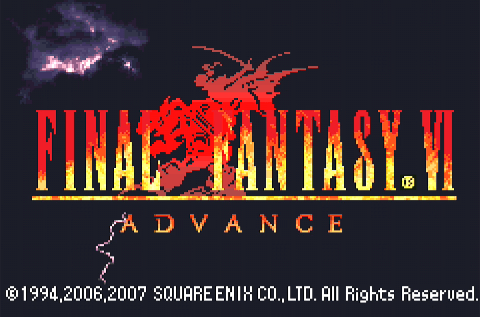
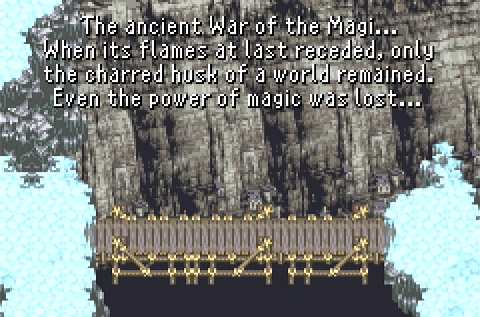
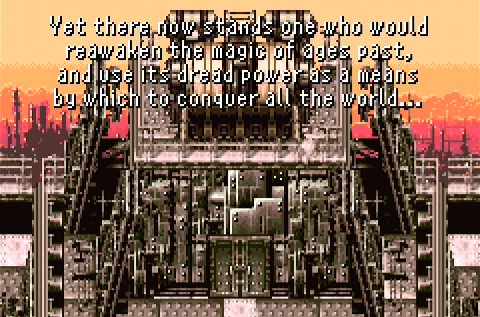
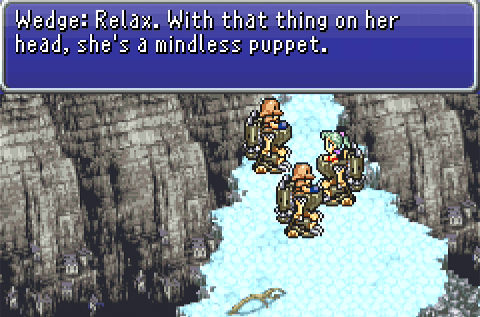
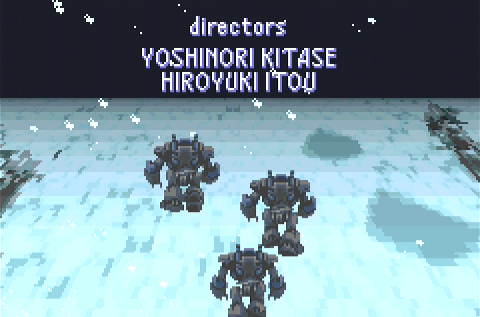
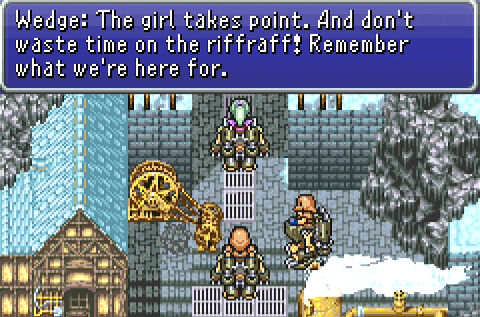

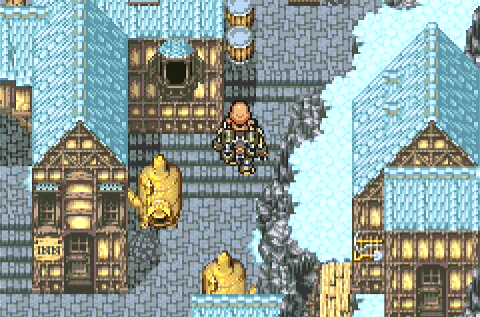
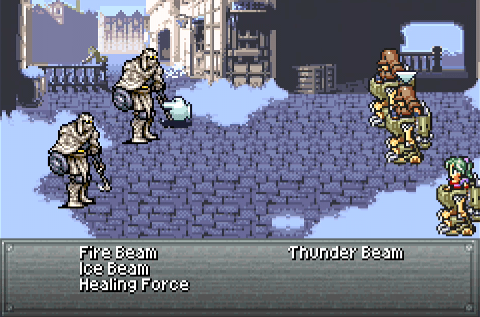
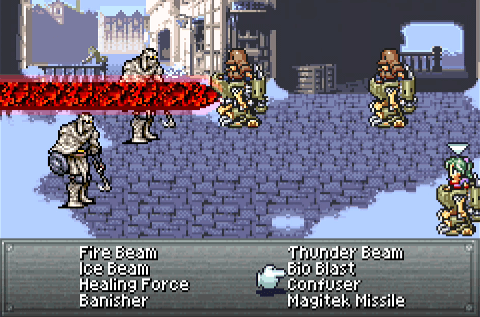
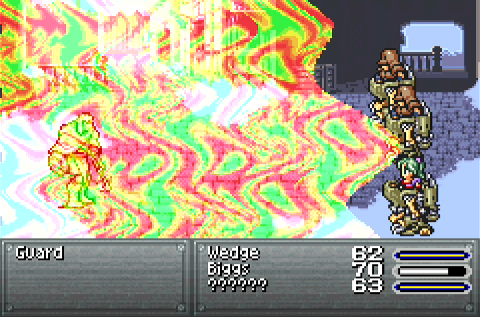
Excited for this series of Anatomy. Though I had played the first 3 Dragon Warrior games on NES, this was the first rpg that I both obtained right at launch and got a bit obsessive over. Definitely a turning point for me as well. Also really enjoyed that strategy guide which I no doubt obtained by adding another year to my Nintendo Power subscription.
Yesssss, one of my all-time favorites and quite the nostalgia hit. This was why I had to have a video adapter in the Mac in my college dorm room.
That introductory scene will always be amazing, and the ‘tutorial’ is such a great bit of subtle plot-adapted design.
That’s crazy, I also had a video adapter in my Mac in college just to play this (and some other SNES games I brought along). The music was so fantastic. Totally looking forward to this series of “Anatomy”.
Any chance at some point you might dable in doing an anatomy for Ultima 1 or Dragon Quest 1? Would really like to see what input you would say on these very early rpg games.
Man I remember first playing this game on Final Fantasy Anthologies collection. My friends had tried to get me into Final Fantasy 7, but that game didn’t click with me till after I had found and devoured FF6. I’ve never really sat down and looked at an RPG from a critical eye like this, so I’m really excited to read these articles.
Wow, you discovered FFVI through Anthology and you still like it? That’s hardcore.
Well, to be fair, part of the reason he liked it so much is that the game was functionally designed to give you time to go to the bathroom, get a drink, make a phone call, whatever you needed, all while the loading screens were going on. None of this high-pressure hard sell kind of stuff so many other games went out of their way for; FF Anthology gave you the time to really get out there and live you life, then come back and fight a battle whenever you felt like it. We’ve really lost something in game design, I think. I mean, sure, there are plenty of games out there that are immersive and interesting and really offer great gameplay experiences, but playing Chrono Trigger on the FFAnthology collection taught you patience in a way nearly no other experience in life ever will.
I suddenly regret that I have not implemented a karma system here.
Wow. Pumped for this. This is easily my favorite FF game. The opening credits with the Magitek Armor walking through the snow is my favorite intro in a video game ever.
Very excited to see where this goes.
That opening cinematic blew me away as a kid. I can hear the eerie, low-key Narshe music now. Complete with intermittent, raspy sighs.
Mr. Thou! Mr. Thou!
Ugaaaaaaa!!
Love this. Can’t wait for the rest.
Son of a submariner!
I am a huge fan of your “Anatomy of Games” series - as well as a fan of most of your writing, come to think of it, but I am still incredibly happy that this game is next in line 😉
‘This was the turning point for me, the moment at which I rounded a corner from “kind of interested in RPGs but not really sure if they were my thing” to “pretty much fixated on them.”’
This was so true for me: Before FFVI, I had only ever dipped my toes into JRPGs, but I wasn’t really certain whether I actually liked the genre. FFVI, on the other hand, truly seemed like something else: From the moment I saw the three Magitek suits walk through a snowstorm towards Narshe, I knew that this was something precious, something to be savoured. And I was utterly blown away by the ingeniousness of it all: The world, the storytelling — I loved it all the way through. I even downloaded an FAQ from the Internet when the internet was still something mythical and dangerous, at least to me (the FAQ lacked all the spaces in between the words, due to hokey formatting, and I still read it). I still loved the game after the (amazing) ending sequence stopped playing halfway through due to me playing this via adapter on a European SNES (it would take until the release of Anthology for me to finally see it in its entirety). And I have loved the game ever since, and it may be the Final Fantasy game I have played through the most times. It still ranks amost my favourite games (and my top three Final Fantasies) today. I am so looking forward to the next posts…
Hm, I still need to finish this. XD Perhaps I’ll pick up where I left off once you get there. Definitely a great beginning to a game, though. I missed out on the 16-bit days when I was young, and I’ve been relishing experiencing Genesis and Super NES titles now that I didn’t get the chance to when it was happening.
Back in the day, my only source of non-Nintendo information was a magazine translated from Swedish (in Norway, there was not a huge market for domestic magazines, and import magazines like CVG covered a lot of PC engine, Amiga and Neo Geo stuff that was hard to get and impossible to pay). One of the journalists was an RPG freak, and I read his article on FF IV (II) with huge interest and a lot of desire. Only problem was that an US import cost 200 USD and required an adapter (which, according to official Nintendo lore, was likely to make your SNES explode). Hence, I didn’t get FFIV at the time, but having worked like an idiot for a whole summer picking golf balls, I could finally afford an US RPG import. Only problem was that FFVI featured copy protection, meaning that you’d need another 300 bucks to make it work properly. I bought Chrono trigger instead, and loved it. It was only after having worked like an idiot for another summer that I could afford to mod my SNES and then buy FFVI. I absolutely loved it, though, and it is still a highlight of visiting my parents (once a year) to start up that Narshe intro. I don’t need it for CT anymore, having bought the DS port.
A long rant here, but I am very happy that you treat this game (I’ve loved every part of this series except possibly Donkey Kong, which happened before my day). I love your work, Parish, keep it up.
I have nothing to add but “Hooray!”
…and maybe Vanish/X-Zone
That doesn’t work in this version!